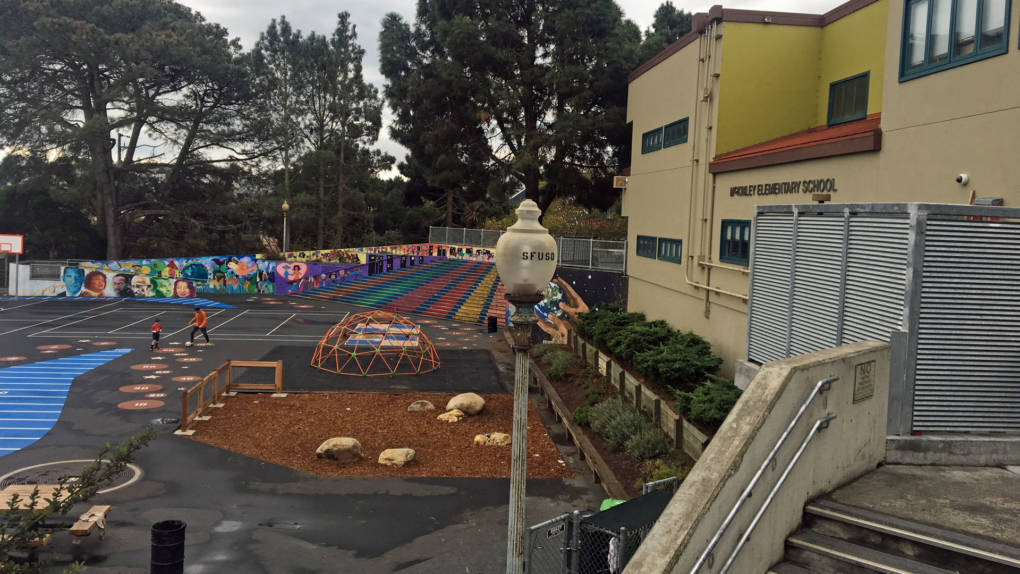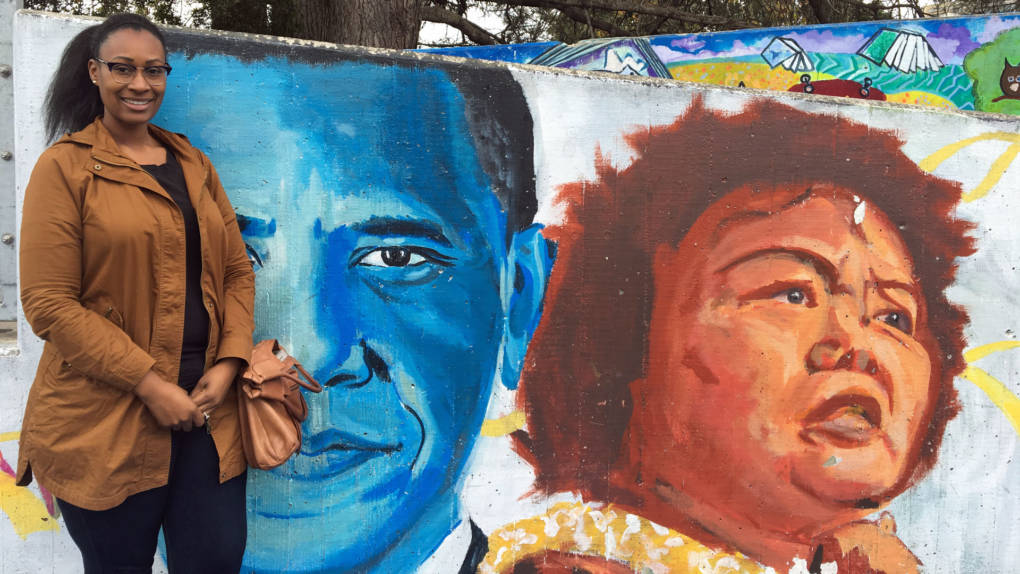Update: On Sept. 25, 2018, three school board members brought forward a resolution calling for the end of the current student assignment system.
L
aurel Gaddie and Lamont Lucas try to conduct life as locally as possible. They live in San Francisco’s Duboce Triangle and don’t own a car. They shop locally and walk, bike or ride public transportation when they need to get around. So when it came to finding a kindergarten for their son, Kelvin, local was a priority.
“Proximity was the most important thing and diversity was a close second,” Gaddie said. “We wanted our kids to meet kids from different communities. And third, we were hoping for a Spanish-immersion program.”
The schools that fit those criteria weren’t the most popular ones in San Francisco, so Gaddie felt pretty confident that she’d get something she wanted. But, to make sure, she took some advice about how to list her choices.
“We read a lot on the internet about how to game the system, this famous San Francisco lottery system,” Gaddie said. “And we kind of crafted our first lottery list around that. We listed 17 different schools, only a handful of which we really wanted.”
The first-round assignment offers came out in March. “We were shocked to find we were assigned to something that was not on our list and not in our neighborhood,” Gaddie said.
This is the nightmare of many San Francisco families looking to enroll their children in public school. For many, San Francisco Unified School District’s (SFUSD) student assignment system — called the lottery by many — is a mixture of overwhelming, stressful and baffling.
In many places around the country, where a child lives determines where he or she goes to school. San Francisco doesn’t do that because of segregated housing patterns. Creating diverse schools is a district goal.
“Your opportunity to go to a school shouldn’t be determined by your home address, just like your opportunity to go to a library or a public park shouldn’t be determined by your home address,” said Orla O’Keeffe, chief of policy and operations for SFUSD.

The lottery as we know it today is the product of more than 40 years of trying to solve the problem of segregated schools. In the 1970s, SFUSD tried bussing kids from one neighborhood to another, but parents hated that and many left the district altogether. Next the district tried a combination of parental choice and racial quotas, trying to find a balance between the autonomy parents craved and integration. But race-based admissions were challenged in court and the district had to drop the quota system altogether.
The current lottery system tries to balance parental choice with the district’s goals of integrated schools. It puts the onus of researching and visiting schools on parents, who then list their choices and submit an application to the district office in person. The district prepares student files and puts them into an algorithm programmed to give priority to a few select groups.
How it works
The algorithm randomly selects a school and then looks at all the students who listed that school as a choice anywhere on their list and puts them in a pool together. The computer then fills the available spots at the school based on tiebreakers. The tiebreakers are:
- Sibling preference — if the student already has a sibling at the school.
- Census Tract Integration Preference (CTIP) — kids who live in parts of the city with the worst test scores.
- Attendance area — kids who live in the designated attendance area for that school.
If there are more spots at the school after all the kids with tiebreakers have been placed, the algorithm fills the remainder randomly from the pool of people who requested it.
This same process happens for every school until the only schools with open spots are ones that none of the remaining unassigned children listed. At this point in the process, some kids might have been tentatively assigned to more than one school because they had strong tiebreakers. This is when the algorithm takes into account where a school was ranked on the student’s list. It drops the child from every school except the highest-ranked choice. Now there are open spots again, which the algorithm fills from the group of kids who have not been assigned any school yet.
At this point, the district built in something called a “swapping mechanism” on the advice of some economists who said it would help prevent parents from trying to “game the system.” During the swapping phase, the algorithm sees if there are any two children who could both be happier if they trade their spots. The district says the swapping mechanism affected 10 percent of Round 1 kindergarten offers in the 2017-18 school year.
After all that, there are still some unlucky kids who haven’t been assigned to a school. They didn’t get any of their choices, so the district places them in a school with open spots based on proximity to their home address.
The district sends the first-round assignments in March, at which point parents can either decide to enroll in the school they received or enter the second round of the lottery. People who miss the deadline can also enter in the second round, but the number of options is smaller because some portion of families took their first-round offer.
If parents still don’t get a school they are happy with after the second round, they can put their child on the waitlist for one school, in case a child enrolled there leaves. Some kids do get into their first-choice school at the last minute this way. If a child receives an offer off the waitlist, she has to take it, even if she’s already happy at a different school.
How do parents feel about it?
Some parents feel this lottery system is overly complicated and stressful to families, but for others, CTIP is the only way that their children can access better schools. Raquel Knighten lives in the Bayview, but sends her kids to Rooftop, a highly coveted school on Twin Peaks. Her two kids ride a school bus to get there every day.
Knighten wishes the schools in her neighborhood were better, so that she didn’t feel forced to send her kids far away. She’d like the luxury other parents seem to have, choosing schools based on language programs or a focus on the arts. She’s just glad her kids aren’t going to an underperforming school.
“There’s a lot of anxiety, but I think overall, it’s a much better feeling than, ‘Your child has to go to this school.’ And you have no options,” Knighten said. She’s frustrated with parents who complain about the lottery without considering what that choice means to other families.
“I think a lot of parents are selfish,” Knighten said. “They only think about things and worry about stuff when it applies to their children. And they don’t care how it affects other people’s children. I think overall as parents we should be concerned about every child getting an adequate education because every generation goes to the future.”
She’s glad the school district makes an effort to prioritize diversity at its schools.
“I just think we have to teach each other to be more accepting, and you can’t do that if you’re not around people who don’t look like you,” she said.
Knighten chose Rooftop because she had heard from other parents that it was one of the best schools in the city. But parents are making very individual choices about where to send their kids based on geography, work schedules, after-school programming, start times, language programs and more.
Heather Dobbins missed the first-round deadline when her son, Keegan, was applying to kindergarten. Keegan was assigned a school Dobbins didn’t want, so she put him in private school. That didn’t work out and Dobbins ended up home-schooling her son for several months. She entered the public school lottery again for first grade and got the same school — Cobb Elementary. This time she gave it a chance and her son loves it.
“Now we know, look for the schools that have what you need, rather than the top 10 schools on everybody’s list,” Dobbins. She admits in her initial kindergarten search she was close-minded about what a “good” school looks like, but her experience at Cobb has taught her that lots of schools can offer a good fit. But she hasn’t changed her mind about one thing — she still hates the lottery system.
“It’s a burden on every parent, and I’m amazed that more kids don’t go unenrolled,” Dobbins said.
Other parents had a variety of opinions about the lottery. Some didn’t think it was that big a deal — just turn the forms in on time. Others, similar to Raquel Knighten, know that where they live gives them a preference in the lottery, and were weighing choices carefully.
Mink Lincoln-Price has been very worried about how her African-American sons will fare in school. She’s watches the news and sees the reports about how schools are failing black boys. When she visits schools, she’s looking to make sure the leadership understands that this achievement gap is a problem. She wants to hear that principals are actively addressing implicit bias on campus.
“For me it’s really about the academics,” Lincoln-Price said. “Of course I would like them to go to a school where they could have friends that look like them, but of course you can make friends with anybody. Because honestly if they do go to a school with a majority of the kids that look like them, most likely there won’t be any money at that school.”

Sadly, she’s right. All schools get state funding based on the number of students enrolled, so schools with fewer students get less money. Of course, it’s not as simple as that. California’s funding formula portions out more money for schools that serve low-income children, English language learners, and foster kids. But at schools with wealthier parents, it’s not uncommon for the Parent Teacher Association (PTA) to raise hundreds of thousands of dollars to support the school.
Is the lottery making schools more diverse?
Despite the district’s attempt to give families living in parts of the city with low test scores a preference in the school lottery, parents’ choices seem to be patterned. That could be due to the logistics of getting a child to school, but it also could be a sign some parents lack information about the various options around the city. The district makes an attempt to reach out widely with information and nonprofit groups do as well, but often parents get information from one another.
Bilingual and Spanish-immersion programs often draw Latino families who want to be able to help their kids with homework and be able to confer with the teacher. Many parents want a school that’s close to home in case there are emergencies. And few elementary school parents are eager to put their 5-year-olds on Muni buses to attend school across town. The district runs several buses on routes designed to give students more access, but seats are limited.
KQED’s analysis of 2017-2018 kindergarten assignment data shows that almost 60 percent of students attend a school out of their ZIP code — so there’s a lot of moving around. But those numbers varied greatly by geography. For example, 75 percent of kids living in the Outer Richmond stayed there for school, while 87 percent of kids in the Bayview left their ZIP code. And even when students leave their ZIP code, they may not be going far.
“They’re not all going across town,” said O’Keeffe. “In many cases it’s just kind of the next few neighborhoods that they’re going to school to, like the Excelsior, or Vis Valley, the Mission, stuff like that.”
Ultimately, although San Francisco’s choice system does give some kids a way out of their neighborhoods, it isn’t doing a great job of desegregating the district’s schools overall. Choice patterns are just as segregated as housing patterns.
“Choice is complex and it is time-consuming and it does create angst and it’s not currently creating diversity,” O’Keeffe said. “I do think, though, that student assignment alone will never solve for this.”
Still, she says the district is committed to trying. The school board is considering a number of changes to the student assignment process, including doing away with the swapping mechanism.
“We’re concerned that it’s complicated and difficult to understand and that it encourages families to list schools they don’t want as a strategy to get a choice,” O’Keeffe said.
A choice system like this one benefits parents who have the time and wherewithal to seek out information, and the ability to have their children attend the schools they like, even if it’s a difficult commute. O’Keeffe knows this, but says there’s no easy solution.
“If you’ve got choice patterns that are racially isolated, how can choice solve it? And if you’ve got residential patterns that are racially isolated, how can neighborhoods solve it?” she asked.
